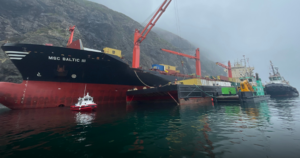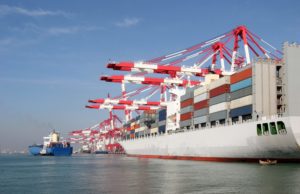A fire had broken out on 29 August 2022 on the Danish ro-ro passenger ship Stena Scandica while en route from Nynäshamn, Sweden, to Ventspils, Latvia.
The Danish Maritime Accident Investigation Board (DMAIB) immediately launched an investigation due to the seriousness of the events, and has now released their accident report on the fire.
The fire broke out in a truck on Stena Scandica’s deck 4 due to a fire ignited and developed on the left side of the gap between the truck and trailer.
In accordance with the report, in that area a number of different sources of ignition were observed, but the investigation could not conclusively establish the primary cause of ignition.
The fire was quickly detected by the crew, and the fire was extinguished before it spread to other vehicles or compartments.
Electrical cables essential for the operation of the ship were damaged by the fire, which resulted in a major failure on the power supply system and caused a complete blackout.
The crew was unable to manoeuvre the ship and fully deploy the anchors, and the ship drifted uncontrollably for 6.5 hours towards the shallow waters off the island of Fårö.
While the crew were making efforts to restore power and propulsion, it was planned to evacuate passengers by means of helicopter and lifeboat.
Evacuation of passengers by helicopter was initiated, while evacuation by lifeboat was postponed as the restoration of power was progressing, and it was deemed safer for the passengers to stay on board.
Thirty-three passengers were evacuated by helicopter before power was restored, and the ship returned to port. No passengers or crewmembers were injured, in accordance with the DMAIB investigation report.
The investigation found also that the fire on the vehicle deck was quickly brought under control and extinguished.
DMAIB highlights the fact that “critical electrical infrastructure with no structural fire protection, or redundancy, was installed below the deckhead above the vehicles and was thereby directly exposed to the fire hazard.
“The fire therefore resulted in power cables essential to the operation of the ship being damaged. The damaged cables created a cascading effect of major power supply failures, leading to a loss of directional control and immobilisation of safety critical equipment such as fire-extinguishing systems and anchors.”
The emergency procedures and decision support system available to the crew were standardised documents that relied on all the emergency systems being in working order.
“They did not cover the situation experienced on board with multiple system failures, including failure on power backup systems, and did not aid the crew in resolving the situation and taking decisions.
“The restoration of power therefore relied solely on the crew’s skills and their ability to apply their resourcefulness in stressful circumstances and to make difficult decisions based on imperfect information,” as the report concludes.
The full investigation report on the incident can be found here.



